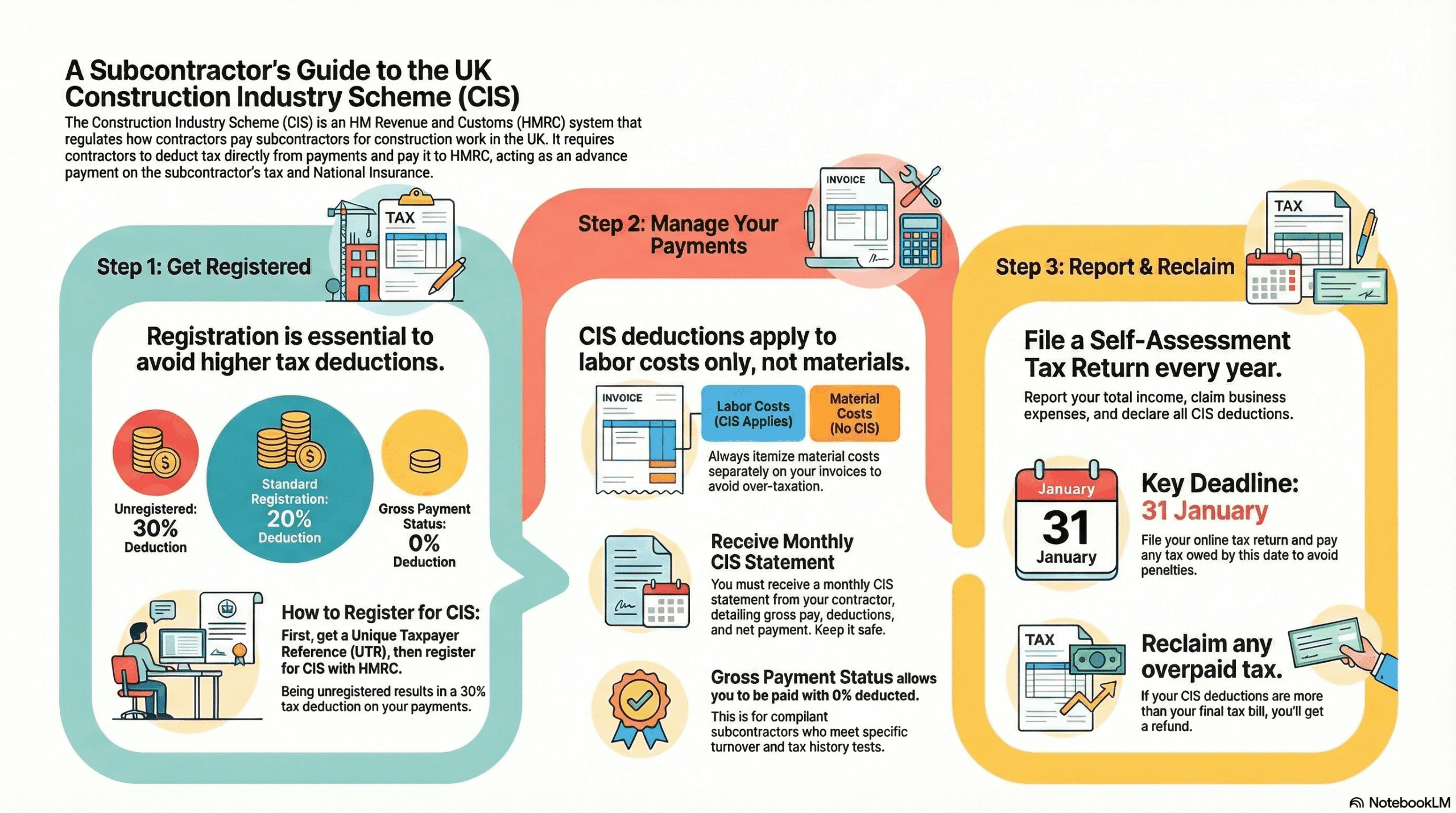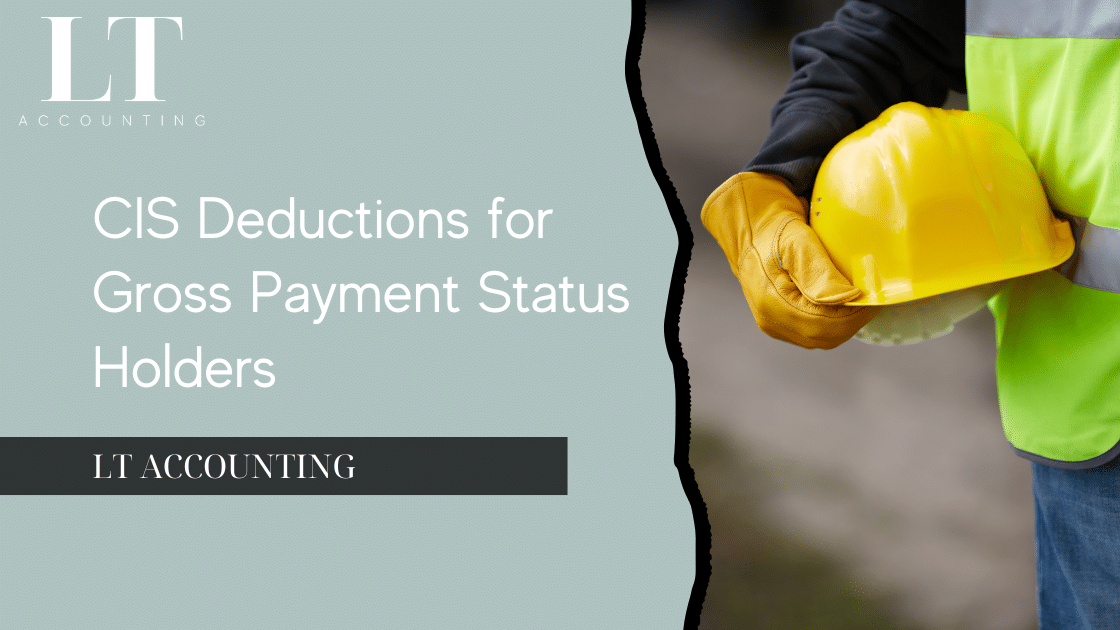For those working in the UK construction sector, understanding the Construction Industry Scheme (CIS) is not just advisable – it’s essential. Whether you’re a sole trader, part of a partnership, or operating as a limited company, subcontractors must be aware of their legal obligations under the scheme. Failure to comply with CIS regulations can lead to significant financial penalties, delays in payments, or tax inefficiencies.
This article provides a comprehensive guide to the CIS requirements specifically for subcontractors. We’ll cover everything from initial registration and how deductions work, to submitting tax returns and avoiding common pitfalls. With construction being one of the most scrutinised industries by HMRC, staying on top of CIS obligations can mean the difference between smooth operations and costly compliance issues.
At LT Accounting, we work closely with subcontractors across the UK to ensure they’re fully compliant with CIS while maximising their tax efficiency. Whether you’re new to the industry or need a refresher, this guide is designed to help you navigate the complexities of the scheme with clarity and confidence.

What is the Construction Industry Scheme (CIS)?
The Construction Industry Scheme (CIS) is a tax deduction system established by HM Revenue and Customs (HMRC) to regulate how payments to subcontractors for construction work are handled. Introduced to combat tax evasion within the construction sector, the scheme ensures that tax is deducted at source from payments made by contractors to subcontractors.
Who Does the CIS Apply To?
The scheme specifically applies to:
-
Contractors: Businesses or individuals who pay subcontractors for construction work.
-
Subcontractors: Those who carry out construction work for contractors.
A business may fall into both categories depending on its operations. However, this article focuses entirely on subcontractors – that is, individuals or entities receiving payments for construction work under a contractor’s instruction.
Types of Work Covered Under CIS
The CIS applies to most types of construction work carried out in the UK, including:
-
Site preparation (e.g., laying foundations)
-
Demolition and dismantling
-
Building work (commercial, residential, or civil)
-
Alterations and repairs
-
Decorating and finishing
-
Installation of systems (e.g., heating, lighting, power, water)
It’s worth noting that some professional services such as architecture, surveying, and certain facilities management services are excluded from CIS, though related construction work is not.
Why the CIS Exists
HMRC established the CIS to ensure proper reporting and collection of taxes in an industry where self-employment is common and cash-based transactions were historically widespread. Under the scheme, contractors are required to deduct money from a subcontractor’s payment and pass it on to HMRC as advance payments towards the subcontractor’s income tax and National Insurance contributions.
The Financial Implications
The core idea is that subcontractors will have their tax partially paid throughout the year rather than facing a large liability at year-end. However, subcontractors must keep thorough records and submit accurate tax returns to ensure:
-
Overpaid tax can be reclaimed.
-
Underpayments are correctly reconciled.
-
Their eligibility for Gross Payment Status (explained later) is protected.
As we’ll explore in the next sections, being proactive and accurate in your CIS responsibilities can significantly impact your cash flow and tax liabilities – which is where professional guidance becomes invaluable.
Registering for CIS as a Subcontractor
Registering for the Construction Industry Scheme (CIS) is one of the most important first steps any subcontractor must take when working in the UK construction sector. Whether you operate as a sole trader, a partnership, or through a limited company, registration with HMRC under CIS is not optional if you’re being paid for construction work by a contractor. It’s essential to ensure the correct amount of tax is deducted from your payments and that you avoid the higher deduction rate reserved for unregistered subcontractors.
In this section, we’ll cover everything you need to know about CIS registration, including how to register, what information you’ll need, and the implications of not registering.
Why You Must Register for CIS
The most immediate benefit of registering for CIS is that it reduces the rate at which contractors deduct tax from your payments. Registered subcontractors are subject to a 20% tax deduction at source, while unregistered subcontractors are hit with a much steeper 30% rate. Over the course of a year, that 10% difference can have a serious impact on cash flow and the overall tax efficiency of your business.
Beyond the deduction rate, being registered:
-
Establishes you as a legitimate business in HMRC’s eyes
-
Enables you to apply for Gross Payment Status (where applicable)
-
Reduces the likelihood of delays in receiving payments from cautious contractors
Who Can Register?
CIS registration is open to any individual or business operating as a subcontractor in construction. This includes:
-
Self-employed individuals (sole traders)
-
Partnerships
-
Limited companies
Regardless of structure, you must be engaged in construction operations within the UK, and you must be receiving payments from contractors for work covered under the scheme (as outlined in the previous section).
Steps to Register for CIS
The process of registration is relatively straightforward, but it’s vital that all information submitted is accurate and up to date to avoid delays.
1. Obtain a Unique Taxpayer Reference (UTR)
Before you can register for CIS, you need to be registered for self-assessment with HMRC. This will provide you with a Unique Taxpayer Reference (UTR), which is necessary for all CIS interactions.
You can register for self-assessment online at GOV.UK, and your UTR is usually issued within 10 working days.
2. Register for CIS as a Subcontractor
Once you have your UTR, you can register for CIS online or by contacting HMRC directly. The process depends on your business type:
-
Sole traders can register online using their Government Gateway account.
-
Limited companies will need to register via the HMRC CIS helpline or an authorised agent like LT Accounting.
-
Partnerships follow a slightly different route, involving the nomination of a responsible partner and additional details about the partnership structure.
During the registration, you’ll be asked to provide:
-
Your UTR
-
National Insurance Number (for individuals)
-
Business name and trading name (if different)
-
Business address
-
VAT number (if applicable)
-
Company registration number (for limited companies)
3. Confirmation of Registration
Once successfully registered, you’ll receive confirmation from HMRC. Contractors will then be able to verify your CIS status using your UTR and National Insurance number (or Company Registration Number for limited companies). This allows them to apply the correct deduction rate to your payments.
What Happens If You Don’t Register?
Subcontractors who fail to register for CIS are still subject to deductions, but at the higher rate of 30%. This can create cash flow problems, especially if you’re waiting to reclaim overpaid tax through your annual self-assessment.
Additional risks include:
-
HMRC penalties for inaccurate tax filings
-
Ineligibility for Gross Payment Status
-
Hesitancy from contractors to engage unregistered subcontractors due to verification issues
It’s also worth noting that even if you only occasionally carry out construction work, you may still fall under CIS. If in doubt, it’s always safer to register — or speak with a qualified accountant like LT Accounting to assess your obligations.
Can I Register Through an Accountant?
Yes — and in fact, many subcontractors prefer to register through their accountant to ensure everything is done correctly from the start. At LT Accounting, we handle the full CIS registration process on your behalf, from obtaining your UTR to ensuring contractors apply the correct deduction rates. This not only saves time but also reduces the risk of administrative errors or missed communications from HMRC.
Next Step: Understanding CIS Deductions
Once you’re registered, the next step is understanding how deductions work, how they affect your payments, and what to look out for on your monthly CIS statements — which we’ll explore in the following section.
Understanding CIS Deductions
Once a subcontractor is registered under the Construction Industry Scheme (CIS), one of the most critical aspects to understand is how deductions work. These deductions are essentially tax withheld at source by contractors, which are then paid directly to HMRC on the subcontractor’s behalf. The system is designed to ensure tax compliance and minimise underreporting of income in the construction sector. However, for many subcontractors, particularly those new to the industry, the deductions process can be confusing and potentially detrimental to cash flow if not managed correctly.
In this section, we’ll cover the deduction rates, how they are calculated, the difference between registered and unregistered subcontractors, and the option of Gross Payment Status for those who meet certain criteria.
Standard and Higher Deduction Rates
When a contractor pays a subcontractor under CIS, they must deduct a percentage from the payment — not including the cost of materials. The percentage deducted depends on the subcontractor’s registration status with HMRC:
-
20% Standard Rate: Applied to subcontractors who are correctly registered for CIS.
-
30% Higher Rate: Applied to those who are not registered with HMRC or where the contractor is unable to verify the subcontractor’s status.
-
0% (Gross Payment Status): No deductions are made if HMRC has granted the subcontractor Gross Payment Status.
It’s vital for subcontractors to understand that these deductions are not additional taxes. They are advance payments toward their eventual tax bill — similar to PAYE for employees. However, if too much is deducted throughout the year, the subcontractor can reclaim the difference via their self-assessment tax return or company accounts.
What is Deducted?
The deduction applies only to the labour element of the payment. If the subcontractor provides materials or hires plant, these costs must be clearly itemised on the invoice so they are excluded from the deduction calculation.
Example:
If your invoice to a contractor is:
-
Labour: £1,000
-
Materials: £300
-
Total: £1,300
Only the £1,000 labour charge is subject to the CIS deduction. If you’re registered, the contractor will deduct 20% of £1,000 (£200), and you will receive £1,100 in total. They will then pay £200 to HMRC on your behalf.
How Contractors Make Deductions
Before making any deduction, contractors must verify your status with HMRC. They do this using your:
-
Unique Taxpayer Reference (UTR)
-
Business name
-
National Insurance number (for sole traders)
-
Company registration number (for limited companies)
HMRC will respond with the correct deduction rate — either 20%, 30%, or 0% — depending on your status. The contractor is then legally obliged to deduct the correct amount and submit it to HMRC as part of their monthly CIS return.
Contractors are also required to provide you with a CIS payment and deduction statement each month, detailing:
-
Gross amount before deduction
-
Cost of materials
-
Amount deducted
-
Net payment to you
These statements are vital for accurate bookkeeping and must be retained for tax and reconciliation purposes.
Gross Payment Status (0% Deduction Rate)
Subcontractors who meet specific criteria can apply for Gross Payment Status, which allows them to receive full payments without any CIS deductions. This can significantly improve cash flow and reduce administrative burden — but it comes with strict eligibility requirements.
To qualify, you must:
-
Be registered for CIS
-
Prove that you have paid your tax and National Insurance on time in the past
-
Operate a UK-based business with a bank account in your business name
-
Meet minimum turnover thresholds (excluding materials):
-
£30,000 for sole traders
-
£30,000 for each partner in a partnership or each director in a company (or £100,000 in total for the whole partnership/company)
-
If granted, Gross Payment Status is reviewed annually, and failure to keep up with tax obligations can result in it being revoked.
At LT Accounting, we regularly assist clients in applying for Gross Payment Status and maintaining compliance throughout the year. Our proactive management helps ensure our subcontractor clients avoid any unnecessary deductions or penalties.
Consequences of Incorrect Deductions
Mistakes can occur if a contractor:
-
Applies the wrong deduction rate
-
Fails to deduct at all
-
Incorrectly calculates the labour/material split
As a subcontractor, it’s essential to:
-
Review your CIS statements monthly
-
Keep copies of all invoices and CIS documentation
-
Maintain up-to-date records for your accountant
If over-deductions have been made, these can be reclaimed either through your self-assessment tax return (for individuals) or through your company’s PAYE scheme (for limited companies). An experienced accountant can help you recover this money quickly and efficiently.
The Role of Your Accountant
Having a knowledgeable accountant familiar with CIS is crucial. At LT Accounting, we ensure our subcontractor clients:
-
Are correctly registered
-
Have deductions accurately reconciled
-
Maintain proper records for HMRC compliance
-
Receive support when applying for Gross Payment Status
-
Get maximum benefit from allowable expenses and reclaimable tax
We also liaise directly with contractors and HMRC on behalf of our clients, saving them time and ensuring peace of mind.
Receiving Payments and CIS Statements
After registration and understanding how deductions work under the Construction Industry Scheme (CIS), the next key area for subcontractors is managing payments and CIS statements issued by contractors. These records form the backbone of your financial documentation, are essential for your tax reporting, and play a major role in ensuring that you are paid correctly and timely under the scheme.
This section explores what subcontractors should expect to receive from contractors, how to interpret CIS statements, and why meticulous record-keeping is essential.
What Contractors Must Provide
Every time a contractor makes a CIS-related payment to a subcontractor, they are legally required to provide a written CIS Payment and Deduction Statement. This document must be issued within 14 days of the end of the tax month (which runs from the 6th of one month to the 5th of the next).
The statement must include the following details:
-
Contractor’s name and registration number
-
Subcontractor’s name and UTR
-
Gross payment amount (before CIS deduction)
-
Amount of materials (if applicable)
-
Amount deducted for CIS
-
Net payment made to the subcontractor
-
Date of payment
-
Tax month the payment applies to
These statements should be issued monthly, even if there is no payment due for that period (i.e., a “nil return” month). Failing to issue these can result in penalties for the contractor, but it also creates serious complications for subcontractors trying to reconcile their accounts or file their tax return.
Reviewing and Interpreting Your CIS Statements
As a subcontractor, it’s vital that you carefully review each CIS statement for accuracy. Mistakes in CIS deductions, materials calculations, or identification details can lead to:
-
Overpaid tax, reducing your available cash flow
-
Incorrect or delayed tax refunds
-
Potential issues with HMRC if under-reporting is suspected
Key Points to Check:
-
Gross vs Net Payment: Ensure the gross amount matches your invoice (minus only the materials).
-
Materials Breakdown: Make sure materials are properly itemised and deducted from the taxable amount.
-
CIS Deduction Rate: Confirm the correct rate (20%, 30%, or 0%) has been applied, based on your registration status.
-
Tax Month: Verify the timing is correct for your records and matches payment dates.
-
Statement Consistency: All monthly statements should follow a standardised format and be kept together.
Handling Discrepancies
If there is an error in a CIS deduction or statement, the issue should be raised with the contractor immediately. Most disputes arise due to:
-
Incorrect deduction rates being applied
-
Misunderstanding over what constitutes “materials”
-
Inaccurate gross figures due to late or amended invoices
If the contractor does not resolve the issue or there are repeated errors, an accountant can assist in formally challenging the discrepancies and liaising with HMRC to adjust reported figures.
At LT Accounting, we frequently resolve CIS disputes on behalf of our subcontractor clients, helping ensure accurate deductions are reflected in their tax records and preventing long delays in refunds or assessments.
Why Record-Keeping is Essential
While contractors are required to report CIS deductions to HMRC, subcontractors must maintain their own records for compliance, auditing, and tax return purposes.
Recommended Records to Keep:
-
Copies of all invoices issued to contractors
-
All CIS deduction statements received
-
Bank statements showing payment receipts
-
Proof of materials purchased (invoices and receipts)
-
Correspondence regarding disputed payments or deductions
These records should be stored securely for at least six years, in line with HMRC’s requirements for business record retention.
Proper record-keeping:
-
Supports your self-assessment or company tax return
-
Helps in claiming back any overpaid tax
-
Reduces the risk of penalties during HMRC reviews
-
Strengthens your application or continued eligibility for Gross Payment Status
Best Practices for Managing Payments and CIS Documentation
To streamline your finances and avoid administrative headaches:
-
Use accounting software or work with a bookkeeper to track CIS income and deductions
-
Reconcile CIS statements against bank receipts monthly
-
Chase contractors promptly for missing or incorrect documentation
-
Schedule regular reviews with your accountant to ensure your records align with HMRC data
LT Accounting provides full support for managing and maintaining CIS documentation. We ensure that all CIS payments and deductions are correctly processed, recorded, and reported — giving you peace of mind that your finances are fully compliant and ready for your tax obligations.
Tax and Record-Keeping Obligations for CIS Subcontractors
Compliance with the Construction Industry Scheme (CIS) doesn’t end with receiving accurate payment and deduction statements from contractors. As a subcontractor, you also have specific tax obligations and record-keeping requirements to meet throughout the financial year. These responsibilities are essential to ensure your tax is correctly calculated and reported, deductions are properly applied, and your business stays on the right side of HMRC.
This section explores how CIS deductions affect your overall tax liability, what needs to be reported to HMRC, and why professional bookkeeping is indispensable to your success as a subcontractor.
How CIS Deductions Affect Your Tax Position
CIS deductions are advance payments toward your income tax and (if applicable) National Insurance contributions. The way they are treated depends on your business structure:
Sole Traders and Partnerships
For self-employed subcontractors, the deductions made by contractors are reported on your Self-Assessment Tax Return. The amount deducted is subtracted from your overall income tax liability.
-
If too much tax has been deducted during the year, you can claim a refund from HMRC.
-
If not enough has been deducted (e.g., due to expenses reducing your taxable income), you may have to pay additional tax.
Limited Companies
For limited companies, the process is slightly different. CIS deductions made against the company’s income are reported through the company’s PAYE scheme. These deductions can be offset against PAYE and National Insurance liabilities owed to HMRC.
If the deductions exceed your liabilities, you may claim a refund or carry the excess forward to the next tax period. A monthly Employer Payment Summary (EPS) must be submitted to notify HMRC of the CIS deductions suffered.
Key Tax Responsibilities of Subcontractors
-
Keep Full Records of All CIS Deductions
-
Retain monthly CIS statements from all contractors.
-
Keep detailed records of all work done, payments received, and tax deducted.
-
These records must be retained for at least six years in case of HMRC audits.
-
-
Submit an Accurate Tax Return
-
Self-employed subcontractors: Must submit a Self-Assessment Tax Return by 31 January following the end of the tax year.
-
Limited companies: Must file a Company Tax Return, including all CIS deductions, and report PAYE deductions monthly.
-
Partnerships: Each partner must report their share of CIS income and deductions on their individual returns.
-
-
Report Expenses and Allowances
-
You can deduct allowable business expenses to reduce your tax liability.
-
Common expenses for subcontractors include tools, equipment, protective clothing, mileage, public liability insurance, phone bills, and training courses.
-
Proper documentation must be retained for each claim.
-
-
Claiming Back Overpaid Tax
-
If you’ve overpaid tax due to high CIS deductions, HMRC will process your refund after receiving your tax return or PAYE reconciliations.
-
Refunds are typically issued within a few weeks, though delays are common if documentation is incomplete.
-
-
Meet All Filing and Payment Deadlines
-
Late tax returns or payments result in automatic penalties and interest charges.
-
For sole traders, Self-Assessment is due by 31 January; for companies, Corporation Tax is usually due 9 months after the end of the accounting period.
-
Importance of Accurate Bookkeeping
Bookkeeping is more than just a formality — it is essential for:
-
Tracking income and expenses
-
Calculating tax liability
-
Preparing your annual accounts
-
Maintaining eligibility for Gross Payment Status
-
Supporting claims in the event of HMRC enquiries
Poor bookkeeping leads to under-claimed expenses, tax overpayments, late filings, and ultimately, lost income.
At LT Accounting, we provide tailored bookkeeping services for subcontractors, ensuring:
-
All CIS income and deductions are correctly recorded
-
Expenses are tracked and categorised for tax efficiency
-
Accounts are prepared in line with HMRC requirements
-
Clients are ready for Self-Assessment or year-end filings with minimal hassle
Digital Record-Keeping and MTD for Income Tax
With the introduction of Making Tax Digital (MTD), digital bookkeeping is becoming mandatory for many subcontractors from April 2026. MTD for Income Tax Self-Assessment (ITSA) will require digital records and quarterly updates for self-employed individuals with annual business income over £50,000 (reducing to £30,000 from April 2027).
This means:
-
Keeping digital records using MTD-compatible software
-
Submitting income and expense summaries every quarter
-
A final end-of-year declaration
Subcontractors should begin preparing now by:
-
Moving to cloud-based accounting software
-
Receiving training on digital record-keeping
-
Working with an accountant who understands MTD
LT Accounting helps clients future-proof their finances by adopting MTD-ready solutions and providing ongoing training and support.
Filing Self-Assessment Tax Returns with CIS Deductions
For subcontractors operating under the Construction Industry Scheme (CIS), the Self-Assessment tax return is a critical process that determines whether you’ve overpaid or underpaid tax throughout the financial year. While your contractor makes monthly deductions from your payments, it’s your responsibility to submit a final tax return to HMRC that accounts for your actual income, business expenses, and those deductions.
This section explores how to complete a Self-Assessment tax return as a CIS subcontractor, how to reclaim overpaid tax, what documents are required, and the consequences of missing deadlines or providing inaccurate information.
Who Needs to File a Self-Assessment?
If you’re a self-employed subcontractor or part of a partnership, and you’ve received income under CIS, you’re legally required to submit a Self-Assessment tax return each year. Even though CIS deductions are made at source, you must still report your total income, expenses, and CIS deductions to HMRC.
Limited companies do not file Self-Assessment for CIS income — instead, CIS deductions are processed through their company accounts and PAYE scheme (covered previously). However, company directors may still have to complete personal Self-Assessments for other income.
What Information Do You Need to File?
Before you begin your Self-Assessment, gather the following documents:
-
CIS Payment and Deduction Statements (monthly from each contractor)
-
Invoices issued to contractors
-
Bank statements showing income received
-
Receipts for business expenses
-
Mileage logs (if applicable)
-
Annual summary of income and deductions (from your bookkeeping records)
-
Unique Taxpayer Reference (UTR)
-
National Insurance number
Having these documents organised will significantly reduce the stress of filing and increase the accuracy of your return.
How to Complete the Return
-
Register for Self-Assessment
-
If you’ve not previously submitted a return, you must register with HMRC via GOV.UK before 5 October following the end of the tax year.
-
-
Log Into Your Online Account
-
Use your Government Gateway credentials to access your Self-Assessment portal. If you use an accountant, they can submit it on your behalf.
-
-
Enter Your CIS Income
-
Record your gross income before any deductions (i.e., the total invoiced amount).
-
-
Input Your Expenses
-
Enter allowable business expenses such as tools, fuel, PPE, mobile phone use, accountancy fees, and more.
-
-
Record CIS Deductions
-
Enter the total CIS tax already deducted by contractors. This is found on your monthly CIS statements.
-
-
Submit Your Return
-
Once complete, review your return carefully. Any overpaid tax will be refunded after submission and HMRC’s processing (usually within a few weeks if bank details are provided).
-
Claiming a Tax Refund
If your total CIS deductions exceed your actual tax liability (after expenses), HMRC will issue a refund. The sooner you submit your return, the sooner you’ll receive it.
Refund Timeline:
-
Typically processed within 2–6 weeks
-
Can be delayed if your return is incomplete or contains errors
-
If you’ve changed bank details, notify HMRC in advance
LT Accounting assists clients in fast-tracking their refunds by ensuring all documentation is accurate and complete before submission.
Key Deadlines and Penalties
Tax Year Period:
-
6 April – 5 April the following year
Submission Deadlines:
-
Paper returns: 31 October
-
Online returns: 31 January
-
Tax payment due: 31 January
Missing the 31 January deadline results in automatic penalties:
-
£100 fine immediately after the deadline
-
Additional penalties at 3, 6, and 12 months
-
Interest charged on late payments
Filing early avoids penalties, provides peace of mind, and allows for early tax refunds.
Common Filing Mistakes to Avoid
-
Failing to report all income (HMRC often receives data from contractors)
-
Incorrectly calculating expenses
-
Omitting CIS deductions
-
Relying solely on bank statements instead of full CIS records
-
Using estimated figures
Using a qualified accountant such as LT Accounting drastically reduces these risks and ensures full compliance.
How LT Accounting Helps with Your CIS Self-Assessment
We offer a comprehensive Self-Assessment service tailored specifically for subcontractors under CIS. Our services include:
-
Collating CIS statements and reconciling them with your income
-
Claiming all eligible business expenses
-
Filing your return accurately and on time
-
Ensuring maximum refund or minimum liability
-
Providing ongoing advice to improve your tax position year after year
For busy tradespeople, having a trusted accountant handle the Self-Assessment process ensures you remain compliant while focusing on your work.
Common CIS Pitfalls for Subcontractors (and How to Avoid Them)
While the Construction Industry Scheme (CIS) offers a structured way for HMRC to collect tax from subcontractors in the construction industry, the system is not without its challenges. Many subcontractors fall into avoidable traps that result in overpaid tax, delayed refunds, compliance issues, or even penalties.
In this section, we explore the most common pitfalls subcontractors face under CIS, why they happen, and how to avoid them with proper knowledge and professional support.
1. Failing to Register for CIS
Problem:
One of the most frequent mistakes is starting work for a contractor without first registering as a CIS subcontractor. While you can still be paid, the contractor is required to deduct tax at the higher 30% rate instead of the standard 20%.
Impact:
This significantly reduces your cash flow and increases the likelihood of overpaying tax, which then needs to be reclaimed through your Self-Assessment tax return.
Solution:
Register with HMRC for CIS as soon as you begin work in the construction industry. Use your UTR number and ensure your details are accurate. LT Accounting can register you directly and make sure you start on the correct deduction rate.
2. Incorrect or Incomplete Details Submitted to HMRC
Problem:
Providing incorrect information during registration or when working with contractors — such as an inaccurate UTR or business name — may prevent successful verification and lead to higher deductions.
Impact:
Contractors may default to the 30% rate, or payments may be delayed until verification is confirmed.
Solution:
Always double-check your UTR, National Insurance number, and contact details. Ensure that your business name is consistent across all records and correspondence. Keep your Government Gateway account up to date.
3. Poor Record-Keeping
Problem:
Subcontractors who don’t keep copies of their CIS deduction statements, invoices, or expense receipts often struggle when completing their tax returns or disputing HMRC queries.
Impact:
This can result in inaccurate tax filings, missed expense claims, and difficulty proving overpaid tax.
Solution:
Keep a monthly folder (physical or digital) with all CIS statements, invoices, and receipts. LT Accounting clients benefit from structured bookkeeping services and cloud-based tools that keep records organised and compliant.
4. Missing Self-Assessment Deadlines
Problem:
Even though CIS tax is deducted at source, subcontractors still need to file a Self-Assessment tax return. Some mistakenly believe they don’t need to file because tax has already been paid.
Impact:
Failure to file results in automatic penalties, and any due refunds are delayed indefinitely.
Solution:
Set reminders and aim to file your return well before the 31 January deadline. LT Accounting provides a proactive service, filing returns early and chasing any outstanding documentation throughout the year.
5. Not Claiming Business Expenses
Problem:
Some subcontractors either forget or choose not to claim expenses because they assume CIS deductions cover all tax obligations.
Impact:
Overpaying tax and missing legitimate savings — leading to lower net profits.
Solution:
Keep receipts and mileage logs. Claim all allowable expenses, including tools, travel, mobile phone use, clothing, insurance, and training. We can help ensure nothing is missed or misclaimed.
6. Confusing CIS With PAYE
Problem:
Subcontractors occasionally confuse CIS deductions with PAYE, believing they are being taxed as employees.
Impact:
This misunderstanding can lead to incorrect tax filings and confusion about allowable deductions.
Solution:
CIS is a separate scheme and is treated as self-employment for tax purposes. You’re responsible for reporting your income and expenses. With LT Accounting, we clarify your employment status and handle all compliance on your behalf.
7. Relying on Contractors for Tax Compliance
Problem:
Some subcontractors mistakenly assume contractors are responsible for handling their tax affairs, beyond making CIS deductions.
Impact:
Incomplete tax returns, missed deductions, and penalties due to non-filing.
Solution:
Understand that you, not the contractor, are responsible for your full tax return and all related obligations. Contractors only deduct tax at source. The rest is your responsibility — or your accountant’s.
8. Losing Gross Payment Status
Problem:
Once obtained, Gross Payment Status (0% deduction) must be maintained by staying compliant with all tax obligations, including timely returns and payments.
Impact:
HMRC can revoke this status if you fall behind, causing a sudden drop in cash flow due to 20% deductions.
Solution:
Stay on top of all filing deadlines and tax payments. LT Accounting monitors client obligations throughout the year to ensure Gross Payment Status remains in place.
Proactive Compliance is Key
The best way to avoid CIS pitfalls is by taking a proactive approach. Know your obligations, keep good records, use accounting software where possible, and work with a trusted advisor who understands the nuances of CIS.
At LT Accounting, we provide end-to-end CIS support — from registration and deductions to year-end filing and refund recovery. Our goal is to help subcontractors stay compliant, maximise take-home pay, and reduce tax-related stress.
How LT Accounting Can Help Subcontractors with CIS
Navigating the Construction Industry Scheme (CIS) can be overwhelming, especially when subcontractors are focused on their day-to-day work and juggling multiple clients. From registration and deductions to tax returns and HMRC compliance, the process is full of technical requirements and deadlines — all of which carry serious consequences if mishandled.
At LT Accounting, we offer comprehensive and tailored support for subcontractors in the UK construction sector. Our goal is to take the complexity out of CIS and allow you to focus on what you do best — without the administrative burden or risk of falling foul of HMRC.
Our CIS Services for Subcontractors
1. CIS Registration and Setup
We handle the entire registration process with HMRC on your behalf — ensuring you’re verified as a CIS subcontractor and eligible for the correct deduction rate. We also assist with applications for Gross Payment Status, increasing your cash flow and removing deductions at source.
2. Bookkeeping and CIS Reconciliation
We manage your bookkeeping throughout the year, maintaining accurate records of:
-
Invoices issued to contractors
-
CIS statements and deductions
-
Materials costs and allowable expenses
This ensures everything is properly reconciled when it’s time to file your return.
3. Self-Assessment Tax Returns
We prepare and submit your Self-Assessment Tax Return, ensuring:
-
All CIS deductions are reported and credited
-
All eligible expenses are claimed
-
Tax is calculated accurately
-
Refunds are processed as quickly as possible
For limited companies, we also handle your year-end accounts, PAYE reconciliations, and corporation tax returns.
4. VAT and CIS Returns
If you’re VAT registered, we ensure your VAT returns align with CIS records. We also help with quarterly and monthly tax submissions, including Making Tax Digital (MTD) compliance.
5. Compliance Monitoring and HMRC Liaison
We act as your agent with HMRC, handling all correspondence and resolving any disputes with contractors or tax authorities. This includes appeals, penalty mitigation, and ensuring you stay in good standing with HMRC throughout the year.
Why Choose LT Accounting?
-
Specialist CIS knowledge: We work with subcontractors daily and understand the unique requirements of construction finance.
-
Personalised support: Every subcontractor’s business is different — we tailor our service to your needs.
-
Proactive approach: We don’t just react at tax time. We provide ongoing guidance to improve your financial position all year round.
-
Cloud accounting tools: We use industry-leading software to make CIS compliance easier, faster, and more transparent.
-
Speedy refunds: Our accurate and timely filings mean you get your overpaid tax back quicker.
Conclusion
The Construction Industry Scheme is a crucial part of working in the UK construction sector, especially for subcontractors. From initial registration and managing monthly deductions to filing tax returns and claiming refunds, every stage requires diligence and attention to detail.
The risks of non-compliance are significant — higher deduction rates, delayed payments, penalties, and even loss of Gross Payment Status. But the rewards of getting it right include improved cash flow, reduced tax liabilities, and financial peace of mind.
By working with LT Accounting, subcontractors gain more than just an accountant — they gain a trusted partner who understands the nuances of CIS, the realities of construction work, and the best ways to stay compliant while maximising profit.
If you’re a subcontractor looking for clarity, efficiency, and expert guidance on CIS — get in touch with LT Accounting today. Let us help you simplify your tax obligations and secure the best financial outcomes for your business.






